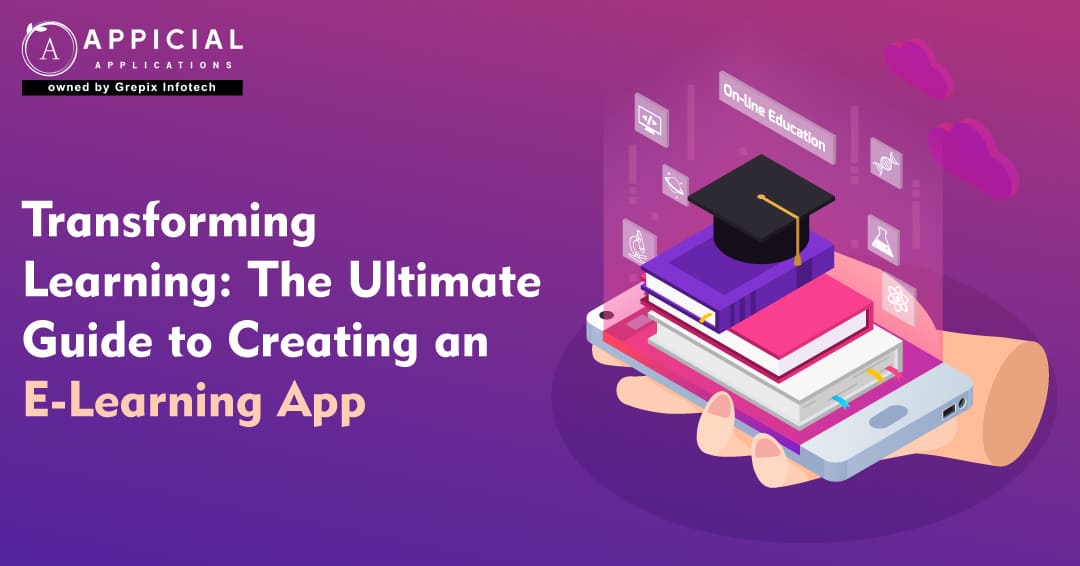
Transforming Learning: the Ultimate Guide to Creating an E-Learning App
In today's fast-paced digital world, the traditional methods of education are being rapidly redefined. The four walls of a classroom no longer confine learning; instead, it has transcended into the limitless possibilities offered by the digital realm. E-learning is at the forefront of this transformation, revolutionizing how knowledge is imparted and acquired. Whether you're an educator looking to extend your reach, a developer with a vision for innovative educational tools, or a business aiming to provide cutting-edge training solutions, creating an e-learning app is an endeavor that promises to reshape the future of education.
This comprehensive guide will take you through the essential steps, features, and considerations necessary to develop a successful e-learning app, setting the stage for a transformative learning experience that caters to the diverse needs of today's learners. Welcome to the ultimate journey of transforming learning through technology.
The blog explores the burgeoning e-learning sector, detailing how to build an app that revolutionizes education. It highlights the need for understanding user requirements and choosing the right educational philosophy and technology stack. The blog covers essential features like accessibility, personalization, and interactive content, emphasizing the importance of continuous user feedback during development. With a forecasted market growth, e-learning apps are crucial for modernizing education and making learning accessible. The blog concludes by underscoring the potential for significant impact in education through innovative e-learning applications, which cater to diverse learning needs and preferences.
Understanding the E-Learning Landscape
Before diving into the development process, it’s crucial to understand the current e-learning landscape. E-learning has evolved from simple online courses to immersive learning experiences incorporating multimedia, interactive elements, and personalized learning paths. The global e-learning market is projected to reach $336.98 billion by 2026, driven by the increasing adoption of online education, corporate training, and the need for continuous learning.
Overview of the E-Learning App Market
The e-learning market has experienced substantial growth, rising from a valuation of USD 380 million in 2022. It is projected to grow to USD 475.76 million in 2023 and further surge to an impressive USD 2872.25 million by 2031. This growth path reflects a compound annual growth rate (CAGR) of 25.20% from 2024 to 2031. This significant increase in market size underscores the growing adoption of e-learning technologies and platforms, which are becoming essential for educational institutions, corporate training, and individual self-paced learning. The trend underscores the escalating demand for accessible, flexible, and cost-effective educational options, which is driving substantial investment and innovation in the e-learning industry.
Key Features of a Successful E-Learning App
An effective e-learning app should cater to the needs of its users—students, educators, and administrators. Here are the key features to consider:
- User-Friendly Interface: A clean, intuitive interface is crucial for engaging learners. Navigation should be seamless, and the design should be responsive to different devices.
- Content Management System (CMS): A robust CMS allows educators to create, update, and manage content easily. It should support various formats such as text, video, audio, and interactive elements.
- Personalized Learning Paths: Adaptive learning algorithms can tailor the learning experience to individual needs, ensuring that each learner progresses at their own pace.
- Assessment and Feedback: Integrating quizzes, assignments, and real-time feedback mechanisms helps in tracking progress and identifying areas for improvement. Gamification: Elements like badges, leaderboards, and rewards can enhance motivation and engagement.
- Social Learning: Features such as discussion forums, group projects, and peer reviews foster a sense of community and collaborative learning.
- Analytics and Reporting: Data analytics can provide insights into learner behavior, course effectiveness, and areas needing improvement.
- Security and Privacy: Ensuring the security of user data and compliance with regulations like GDPR is paramount.
Step-by-Step Guide to Developing an E-Learning App
1. Define Your Goals and Audience
Start by defining the purpose of your e-learning app. Are you targeting K-12 students, higher education, corporate training, or lifelong learners? Understanding your target audience will influence the design, content, and features of your app.
2. Conduct Market Research
Analyze the market to identify trends, opportunities, and competitors. Look for gaps in the market that your app can fill. Surveys, interviews, and focus groups can provide valuable insights into user needs and preferences.
3. Plan Your Content
Content is the heart of any e-learning app. Collaborate with subject matter experts to create high-quality, engaging content. Consider the following types of content:
- Text-based: Articles, eBooks, and notes.
- Video: Lectures, tutorials, and interviews.
- Interactive: Simulations, quizzes, and games.
- Live sessions: Webinars and virtual classrooms.
Ensure that the content is aligned with learning objectives and is accessible to all users.
4. Choose the Right Technology Stack
Selecting the right technology stack is crucial for the functionality and scalability of your app. Consider the following components:
- Frontend: HTML5, CSS3, JavaScript frameworks.
- Backend: Node.js,
- Mobile Development: Native (Swift for iOS, Kotlin for Android) or cross-platform (Flutter, React Native).
5. Design the User Experience (UX)
A great user experience is essential for learner engagement. The design should be intuitive, visually appealing, and accessible. Key considerations include:
- Navigation: Easy access to courses, progress tracking, and settings.
- Accessibility: Support for screen readers, keyboard navigation, and adjustable text sizes.
- Mobile responsiveness: Ensure the app works seamlessly on smartphones and tablets.
7. Implement Key Features
Once the MVP is validated, proceed with implementing the full range of features. This includes:
- User authentication: Secure login and user management.
- Course management: Creation, editing, and organization of courses.
- Interactive elements: Quizzes, discussions, and multimedia integration.
- Notifications: Alerts for course updates, deadlines, and messages.
- Payment gateways: For monetized content and subscriptions.
8. Test Thoroughly
Testing is crucial to ensure the app functions correctly across different devices and scenarios. Conduct various tests, including:
- Unit testing: Testing individual components.
- Integration testing: Ensuring different parts of the app work together.
- User acceptance testing: Real users test the app to provide feedback.
9. Launch and Market Your App
Once testing is complete and the app is refined, it’s time to launch. A successful launch strategy includes:
- Pre-launch marketing: Build anticipation through social media, blogs, and email campaigns.
- App store optimization (ASO): Optimize your app’s listing for visibility.
- Post-launch support: Provide user support and quickly address any issues.
10. Gather Feedback and Iterate
After launch, continue to gather user feedback and analyze usage data. This will help you identify areas for improvement and plan future updates. Continuous iteration based on user feedback is key to maintaining and growing your user base.
Also Read: How to Start Your Taxi Business with inDriver Clone
Challenges in E-Learning App Development
Creating an e-learning app comes with its own set of challenges. Being aware of these can help you prepare and navigate them effectively.
1. Content Quality and Relevance
Ensuring high-quality, relevant content is essential for learner satisfaction. Regular updates and collaboration with subject matter experts can help maintain content standards.
2. User Engagement
Keeping learners engaged over time can be challenging. Use a variety of content types, interactive elements, and gamification to maintain interest and motivation.
3. Technical Issues
Technical challenges such as server downtime, bugs, and performance issues can affect the user experience. Regular maintenance, testing, and updates are crucial to ensure smooth operation.
4. Data Security and Privacy
Protecting user data and complying with privacy regulations is paramount. Implement robust security measures and stay informed about regulatory changes to safeguard user information.
Future Trends in E-Learning
The future of e-learning is promising, with several trends shaping the industry:
1. Artificial Intelligence (AI)
AI can personalize learning experiences, provide real-time feedback, and automate administrative tasks. AI-powered chatbots, for example, can assist learners 24/7.
2. Virtual Reality (VR) and Augmented Reality (AR)
VR and AR can create immersive learning experiences, such as virtual labs, historical recreations, and interactive simulations, enhancing engagement and understanding.
3. Microlearning
Microlearning, or bite-sized learning, caters to the modern learner's preference for short, focused content. This trend is particularly effective for mobile learning.
4. Social and Collaborative Learning
Social learning platforms that facilitate collaboration and peer interaction are becoming increasingly popular. These platforms mimic social media, making learning more engaging.
5. Blockchain
Blockchain technology can enhance the security and transparency of educational records and credentials, making it easier to verify qualifications and achievements.
Conclusion
In conclusion, creating an e-learning app represents a transformative journey that necessitates meticulous planning, innovative execution, and continuous enhancement. By delving into the dynamic e-learning landscape, we can identify the critical features that drive successful apps—from user-friendly interfaces and robust content management systems to personalized learning paths and gamification elements. Understanding and implementing these features ensures the development of a platform that meets diverse educational needs and elevates the learning experience.
This comprehensive guide has walked you through the essential steps of developing an e-learning app, from defining your goals and conducting market research to designing user experiences and testing thoroughly. The importance of launching with a solid MVP, gathering user feedback, and iterating based on real-world usage cannot be overstated. Moreover, staying ahead of challenges such as content quality, user engagement, technical issues, and data security is crucial for maintaining a competitive edge and ensuring user satisfaction.
As we look to the future, emerging trends such as artificial intelligence, virtual reality, microlearning, social learning, and blockchain technology are set to further revolutionize e-learning. By embracing these innovations, you can create an app that not only meets the current demands of learners but also anticipates and adapts to future educational trends.
Ultimately, the goal of creating an e-learning app is to make education more accessible, engaging, and effective for all learners. By following the guidelines and best practices outlined in this guide, you can develop a platform that transforms the traditional boundaries of education, offering learners new opportunities to grow, collaborate, and achieve their full potential. Welcome to the future of learning—where technology and education converge to create limitless possibilities.





